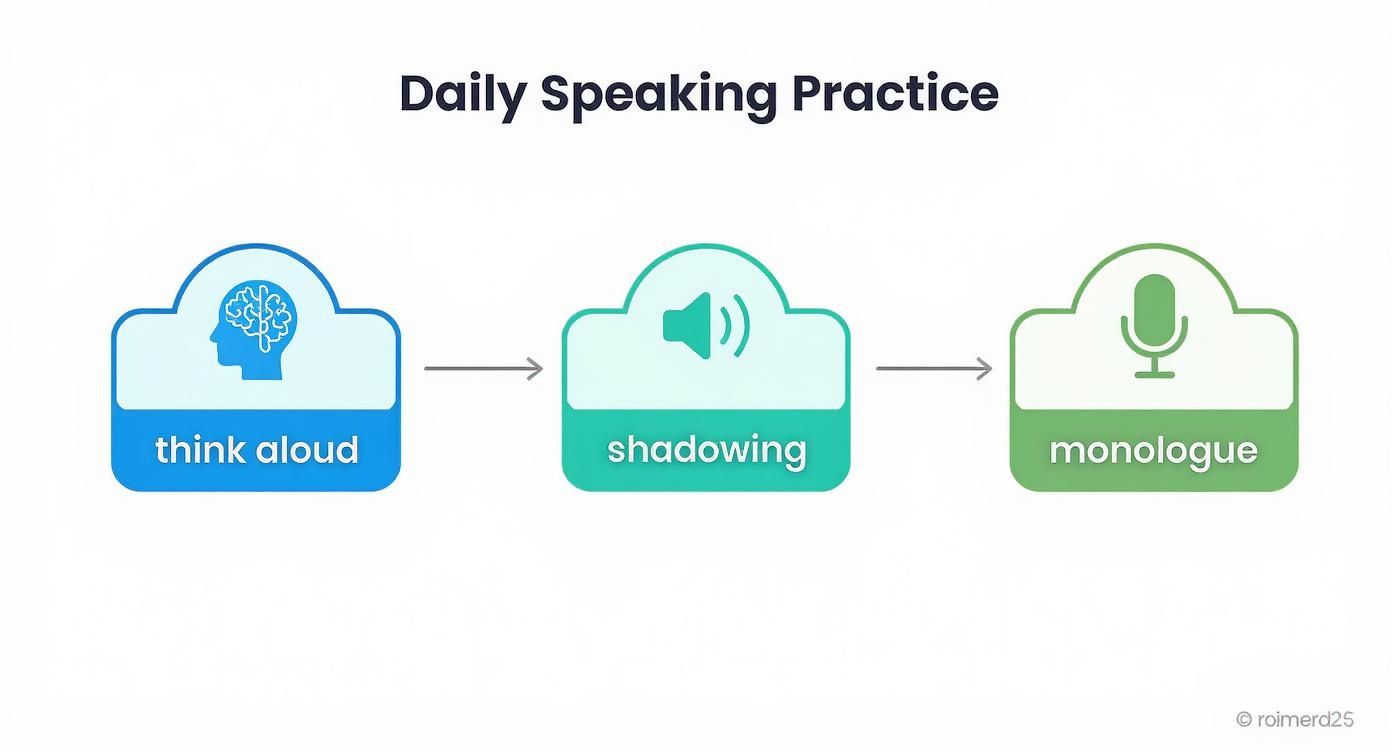How to Learn Speaking English Fluently: A Singapore Guide
So, you want to speak English fluently? The real secret isn't just about memorising grammar rules or cramming vocabulary lists. It’s about building the confidence to actually use the language in your daily life, and that journey starts with getting your head in the right game.
Building the Right Mindset for Fluency
Before we even touch on speaking exercises, let's talk about the most important tool you have: your mindset. So many learners get stuck on the idea that fluency means perfection—speaking without any errors, ever. This is a trap. It creates a fear of making mistakes, which is the number one thing that will stop you from ever speaking at all.
Let’s reframe this. True fluency is simply about clear communication. Can you get your point across? Can people understand you? That's the real goal. Once you accept that mistakes are just part of the process, you give yourself the freedom to practise, experiment, and actually improve.
Find Your Personal 'Why'
Vague goals like "I want to be fluent" just don't cut it when the going gets tough. You need a powerful, personal reason to keep you motivated. What's your 'why'?
Think about what truly drives you:
- Career Growth: Maybe you want to nail that presentation for international clients or lead a team meeting with confidence.
- Social Confidence: Do you want to chat easily with colleagues or make new friends in Singapore’s diverse social circles?
- Personal Fulfilment: Perhaps it's a lifelong goal, a way to make your travels more immersive, or simply a challenge you want to conquer for yourself.
Whatever it is, write it down. Put it on a sticky note on your monitor. This simple act turns learning from a chore into a meaningful mission.
Shifting your focus from "I must be perfect" to "I want to connect" is the single most powerful mindset change you can make. It transforms pressure into purpose, making the learning process more enjoyable and sustainable.
Set Achievable Goals to Avoid Burnout
Trying to go from zero to fluent in a month will only lead to frustration. The key to long-term success is setting small, realistic goals that build momentum. Forget about "speaking perfectly."
Instead, try something like this: "This week, I will have three separate five-minute conversations in English." This is specific, measurable, and achievable. Small wins like these build real, lasting confidence.
Living in Singapore gives you a massive head start. According to a recent global study, Singapore ranks 3rd out of 116 countries for English proficiency. You're living in one of the best places on Earth to immerse yourself in the language. You can find more details on these English proficiency rankings on ef.com. This high-immersion environment makes those small, daily goals feel that much more doable.
Your Daily Fluency Kickstart Plan
To help you turn these ideas into action, here’s a simple plan you can start using today. Just 15-20 minutes a day is all it takes to build a powerful habit.
| Focus Area | Daily Action (15-20 Minutes) | Why It Works |
|---|---|---|
| Mindset & Goals | Review your 'why'. Set one tiny, achievable speaking goal for the day. | Connects you to your motivation and builds a sense of accomplishment. |
| Active Listening | Listen to a 5-minute English podcast or news clip without subtitles. | Trains your ear to the natural rhythm and sounds of English, improving your own cadence. |
| Speaking Out Loud | Describe your surroundings or your plans for the day out loud. | Gets your mouth, tongue, and brain used to physically forming English words and sentences. |
| Vocabulary Boost | Learn one new phrase (not just a word) and try to use it. | Context is everything. Phrases are more practical for real conversations than single words. |
This isn't about adding another huge task to your to-do list. It's about weaving small, consistent efforts into your routine to create big results over time.
Weave Speaking Practice into Your Daily Routine
Real fluency in English isn't something you achieve by cramming for hours on end. It's built in the small, consistent habits you fold into your daily life. The aim is to make speaking English feel as natural as breathing, something you just do without overthinking it.
This is all about turning what you might consider "dead time" into prime practice opportunities. That commute on the MRT? The queue for your morning kopi? Even the time you spend prepping dinner can become a chance to build up your conversational muscle memory.
Narrate Your Day with the Think Aloud Technique
One of the most straightforward yet powerful methods I recommend is the 'think aloud' technique. It's just as it sounds: you simply narrate your actions, what you're seeing, and your thoughts out loud, all in English. Yes, it might feel a bit odd at first, but it’s a brilliant way to shift your internal and external monologue into English.
For instance, when you're making breakfast, you could say to yourself, "Right, grabbing the eggs from the fridge. I think I'll scramble them today. Now, where's that pan? Ah, here it is. Just need a bit of butter."
This simple act does a few crucial things for you:
- It connects words to real-life actions. You're forging a direct link between grabbing the eggs and the English words for that action.
- You're forced to practise sentence structure. This isn't just about recalling isolated words; you’re actively putting sentences together in a completely stress-free situation.
- It activates your passive vocabulary. You start using words you already know but might not say often, pulling them from the back of your mind into active use.
Try starting small. Just narrate five minutes of your morning routine. You'll quickly notice yourself starting to think in English more often, which is a massive leap towards speaking it fluently.
Find Your Natural Rhythm with Shadowing
Ever notice how every language has its own kind of music? The rhythm, the intonation, the way words blend together—this "prosody" is just as important as the vocabulary itself. This is exactly where a technique called shadowing comes in.
Shadowing is where you listen to a native speaker and repeat what they say almost simultaneously, just a fraction of a second behind them. The goal isn't just to copy the words, but to mimic everything: their pitch, their pace, and the emotion in their voice.
Think of it like this: if vocabulary and grammar are the ingredients, then rhythm and intonation are the cooking method. Shadowing teaches you how to 'cook' the language so it sounds authentic and natural.
A great way to get started is with short audio clips, maybe a one-minute news summary or a snippet from a podcast you enjoy. Listen to it once just to get the gist. Then, play it again and speak along with the presenter. Don't stress about catching every single word perfectly—the real focus is on matching the flow and the melody of their speech.
Build Conversational Stamina Through Daily Monologues
A common frustration for language learners is feeling like you run out of things to say mid-conversation. A daily five-minute monologue is a fantastic way to build the mental stamina you need for longer chats.
Just pick a topic you're genuinely interested in—your favourite hawker stall, that new series you're binge-watching, or what you've got planned for the weekend.
Set a timer for five minutes and just talk about it, nonstop. You can use the voice notes app on your phone to record yourself or even learn how to dictate to Google Docs to see your words typed out. This gives you instant feedback, showing you exactly where you pause or struggle to find the right word.
This exercise trains your brain to organise thoughts on the fly and express them clearly, just like in a real conversation. It pushes you to keep going, even when you can't find the perfect word.
And when you're ready to turn those monologues into dialogues, finding a local language exchange in Singapore is a brilliant next step to practise with real people. Remember, consistency is everything. Five minutes every single day is worth so much more than a single hour once a week.
Refine Your Pronunciation and Sound Natural
Knowing all the right words is a great start, but true communication happens when you're easily understood. To really learn to speak English fluently, you have to look beyond vocabulary and focus on the mechanics of speech. This is where you polish your delivery, ensuring your message lands exactly as you intend.
It's not about erasing your accent—that's part of who you are. The goal is to make your pronunciation clear enough for conversations to feel effortless. We’ll dive into some practical ways to get there, tackling everything from tricky individual sounds to the overall rhythm of your sentences.
Master the Mechanics of English Sounds
Let's be honest, some English sounds are a real headache if they don't exist in your native language. Common tripwires include the 'th' sound (think "three" versus "tree"), the classic mix-up between 'l' and 'r', and subtle vowel differences like in 'ship' versus 'sheep'. The only way through is targeted, physical practice.
One of the best things you can do is record yourself. It might feel a bit awkward at first, but it’s an invaluable tool. To get the most out of it, consider investing in a quality microphone for self-recording. A good mic captures the small details, making playback and analysis much more effective.
Listen back to your recording, then find a clip of a native speaker saying the same words and compare. Notice the shape of your mouth and where your tongue is. You can use tools like Forvo or YouGlish to hear words pronounced by different native speakers, which is fantastic for getting a feel for natural variations.
A simple but powerful trick is to use your phone's camera. Record yourself saying a difficult word in slow motion. Actually seeing how your mouth moves can give you that "aha!" moment, showing you exactly what needs to change.
Don't forget to have some fun with it! For a playful way to improve your articulation and build muscle memory in your mouth, check out our guide on using tongue twisters in English.
For learners in Singapore, certain pronunciation habits can be particularly stubborn. Here’s a quick breakdown of common issues and how to work on them.
Common Pronunciation Hurdles and Solutions
| Common Issue | Example | Corrective Exercise |
|---|---|---|
| Dropping final consonants | Saying "han" instead of "hand" | Exaggerate the final 'd' or 't' sound. Record yourself saying lists of words like "hand, sand, band" and listen for the crisp ending. |
| 'Th' sound becomes 't' or 'd' | "Tink" for "think" or "dat" for "that" | Place your tongue between your teeth and blow air. Practice with words: "three," "thirty," "this," "that." Feel the vibration for the voiced 'th' (that) and just air for the unvoiced 'th' (think). |
| Mixing up 'l' and 'r' sounds | Pronouncing "rice" like "lice" | For 'l', the tip of your tongue touches the roof of your mouth just behind your teeth. For 'r', your tongue curls back and doesn't touch anything. Practice pairs: "light/right," "load/road." |
| Vowel length confusion | Short 'i' in "ship" sounds like long 'ee' in "sheep" | Practice minimal pairs. Listen to the difference in words like "sit/seat," "fit/feet," "live/leave." Smile slightly for the 'ee' sound and keep your mouth more relaxed for the 'i' sound. |
Working on these specific areas can make a massive difference in how clearly you're understood.
Understand the Music of English
Beyond single sounds, fluency is all about the 'music' of the language—its rhythm, stress, and intonation. This is what stops you from sounding flat or robotic and makes your speech flow naturally.
-
Sentence Stress: In English, we don't give every word the same weight. We punch the important words (nouns, main verbs, adjectives) and glide over the small ones (articles, prepositions). For example, in "I went to the store to buy some milk," the bold words get the emphasis because they carry the meaning.
-
Intonation: This is simply the rise and fall of your voice. If your voice goes up at the end, it usually signals a question ("You're coming to the party?"). If it falls, it's a statement ("I'm coming to the party."). Nailing this helps you convey emotion and your true intent.
This infographic highlights a few core practices you can build into your daily routine.
Each of these habits—thinking aloud, shadowing, and recording monologues—is a direct route to improving your pronunciation and making your speech sound more natural.
Use Feedback to Polish Your Speech
Practising on your own is vital, but you'll make the biggest leaps with a little outside help. We can't always hear our own mistakes, especially with something as subtle as rhythm. This is where other people become your greatest resource.
Here are a few ways to get solid, constructive input:
- Language Exchange Partners: Find someone patient who's willing to offer gentle corrections. Ask them to focus on just one or two things at a time so you don’t get overwhelmed.
- Professional Tutors: A good language teacher is trained to spot pronunciation patterns. They can give you specific exercises designed for your unique challenges, offering expert guidance that's built around your needs.
- Voice-to-Text Tools: A surprisingly useful trick! Use the dictation feature on your phone or in Google Docs. If the software keeps getting a word wrong, that’s a huge clue that your pronunciation for that word needs a bit of work.
By actively focusing on both the individual sounds and the overall melody of English, you won’t just be easier to understand—you’ll feel a whole lot more confident every time you speak.
Activate Your Passive Vocabulary for Fluent Speech
Ever feel like you’ve got a whole library of English words stuck in your head, but when you open your mouth, only the most basic ones come out? It's a classic, and incredibly common, frustration for language learners.
This is the gap between your passive vocabulary (all the words you recognise when you read or hear them) and your active vocabulary (the words you can actually pull out and use in a conversation). That gap can feel huge, but here’s the good news: you don't necessarily need to learn more words. You just need to activate the ones you already have.
The trick is to build a system that intentionally pulls words from the "recognition" part of your brain over to the "production" side. This is what turns theoretical knowledge into a practical skill, making you sound far more articulate and confident.
Stop Learning Words, Start Connecting Them
One of the most effective ways I've seen learners do this is by ditching isolated word lists. Instead, try building connections with ‘word webs’ or mind maps.
Pick a topic you’re actually interested in—maybe it's your job in FinTech, a passion for urban gardening, or even just your favourite local food. Put that central idea in the middle of a page and start branching out with related words.
Let's say your topic is "Hawker Centres." Your web might look something like this:
- Nouns: queue, tray, aroma, stallholder, ambience
- Verbs: to savour, to recommend, to queue, to patronise
- Adjectives: bustling, authentic, mouth-watering, affordable
This approach works because it mirrors how our brains naturally link ideas, creating much stronger associations than a simple list ever could. Once you've built your web, give yourself a mission for the week: use three to five of these words in real conversations. It's this kind of deliberate practice that really pushes you toward fluency.
I always tell my students this: to really own a word, you need to use it correctly in context at least three to five times. Think of it like creating a path in your brain—the more you walk it, the easier it is to find the next time.
Focus on Collocations to Sound More Natural
If you want to sound less like a textbook and more like a local, you need to learn collocations. These are simply words that naturally belong together in English.
A native speaker wouldn't say, "I will perform an action." They'd say, "I will take action."
Learning these word partnerships is a massive shortcut to fluency. For instance, when you learn the word "decision," don't just stop at the definition. Learn the verbs that travel with it:
- You make a decision.
- You reach a decision.
- You stand by a decision.
- You reverse a decision.
When you internalise these "chunks" of language, you seriously reduce the mental gymnastics required in a conversation. Instead of building every sentence from scratch, your brain can just grab a ready-made phrase that sounds perfectly natural. This makes your speech much smoother and faster.
My advice? Start a dedicated notebook just for collocations you notice when you're reading articles or listening to podcasts.
A Simple Routine to Activate Your Words
To tie all this together, here’s a straightforward weekly routine you can use to consistently move words from passive to active. It’s not about spending hours studying, but about small, focused actions.
-
Choose Your Words (Monday): Pick five target words or collocations for the week. Find them in a book you're reading, a podcast, or even from a meeting at work. The key is that they must be relevant to your life.
-
Write Them in Context (Tuesday-Wednesday): For each word, write at least three different sentences that put it in a situation you might genuinely find yourself in. For the word "streamline," you might write: "We really need to streamline our reporting process to save time."
-
Say Them Out Loud (Thursday-Friday): Now it's time to speak. Intentionally use your target words in spoken sentences. You can do this while talking to yourself, with a language partner, or in a low-stakes chat with a colleague. The goal is just to get the words out of your mouth.
-
Review and Check (Weekend): Take a quick look back at your five words. How easily can you use them now? If they flow naturally, great! They're likely on their way into your active vocabulary. If you're still stumbling, just keep them on your list for another week.
This kind of structured, consistent effort gives you a clear roadmap for waking up the English you already know. It’s how you turn dormant knowledge into dynamic, confident speech.
Create Your Own English Immersion Environment
A lot of people think the only way to get truly immersed in English is to pack up and move overseas. But here's the good news: you don't need a plane ticket to build a rich, English-speaking world right where you are.
Living in Singapore, you're already surrounded by opportunities. The trick is to intentionally make English a living, breathing part of your day, not just another subject you study. This means making a series of small but deliberate choices—shifting your default settings to favour English. This kind of consistent, low-effort exposure is fundamental because it trains your brain to think and react in the language naturally.
Curate Your Digital World in English
Think about it: your phone is probably the first thing you see in the morning and the last thing you check at night. That makes it an incredibly powerful tool for language immersion. With just a few tweaks, you can turn all that screen time into genuine practice.
The easiest change to make right away? Switch your phone’s system language to English. This little trick instantly reframes everyday tasks—unlocking your phone, checking the weather, setting an alarm—as tiny lessons in practical vocabulary. It might feel a bit odd for a day or two, but you’ll get used to it surprisingly fast.
Next, get intentional about the content you consume:
- Social Media: Start following international news outlets, creators, and hobbyists who post primarily in English. This fills your feed with natural, everyday language about topics you already care about.
- Entertainment: Try watching a Mediacorp show or a Netflix series without subtitles. If that feels like too much of a leap, switch to English subtitles instead of your native language. This forces your brain to connect the spoken words with how they look on screen.
- Music and Podcasts: Put together an English-only playlist for your commute. Listening to song lyrics or casual podcast chats is a brilliant way to internalise the natural rhythm and intonation of spoken English.
The goal isn't to understand every single word from the get-go. It's about getting your ears so accustomed to the sounds and flow of English that it stops feeling foreign and starts feeling familiar.
This digital-first approach is especially effective in Singapore, thanks to our deeply rooted bilingual policy. English is everywhere here. The policy, which started back in 1966, made English the main language of instruction in schools. This has caused a massive generational shift—a 2020 survey found that almost 70% of Primary 6 students use English most often at home. You can dig into more fascinating details about Singapore's linguistic landscape on Singstat.gov.sg.
Find Your English-Speaking Community
While digital immersion is a great start, nothing beats real-world interaction for building true speaking confidence. You need to find safe, supportive places where you can practise without worrying about making mistakes. This is how you go from passively listening to actively speaking.
Look for groups that match your personal or professional interests. When you’re all focused on a shared passion, the pressure to speak "perfectly" just melts away. The goal becomes the activity itself, not your grammar.
Here are a few ideas you can explore right here in Singapore:
- Toastmasters Clubs: These groups are specifically designed to help people improve their public speaking and leadership skills in an incredibly structured and supportive setting.
- Hobby Groups: Join a book club, a hiking group, a board game café, or even a pottery class where English is the main language used.
- Professional Networking Events: Attending industry meetups is not only great for your career, but it’s also a fantastic chance to discuss topics you already know well, which makes conversation flow much more easily.
If you’re looking for a more guided path, exploring different English classes for adults in Singapore can provide the expert feedback and peer practice you need to really accelerate your progress.
By thoughtfully shaping both your digital and physical worlds, you create a powerful feedback loop. You’ll hear a new phrase on a podcast, try using it in a chat at your book club, and solidify your understanding. This is how you stop just studying English and truly start living it.
Common Questions on Learning to Speak English
As you get deeper into learning English, it’s completely normal for questions and doubts to pop up. Trust me, every single learner hits a speed bump at some point. It can be a real confidence booster to know you’re not alone in wondering about these things.
This section is all about tackling the most common questions we hear from learners right here in Singapore. We’ll break them down with some clear, practical answers to help you get past these hurdles, stay motivated, and keep moving forward.
How Long Does It Take to Become Fluent?
This is the big one, isn't it? Everyone wants to know when they'll "arrive." But the honest truth is there’s no magic number. Fluency is more of a journey than a final destination, and how long it takes really depends on where you're starting from, how consistent you are, and how much you can surround yourself with English.
Living in an English-rich place like Singapore gives you a real head start. If you’re dedicated, you can expect to see some pretty noticeable improvements in your everyday chat within three to six months of consistent, daily practice. That means feeling more at ease and confident handling casual conversations.
But to get to that next level—where you can dive into complex topics or catch all the subtle jokes and nuances—you're typically looking at a year or more. The best advice I can give is to stop staring at the calendar. Instead, focus on celebrating the small wins along the way. Did you manage a full ten-minute conversation without defaulting to your mother tongue? That's a massive victory.
I'm Afraid of Making Mistakes. How Can I Overcome This?
This fear, sometimes called 'language anxiety,' is probably the single biggest roadblock for most learners. The good news? You can absolutely work through it. The first, most critical step is to completely change how you think about mistakes.
Mistakes aren't failures. They're proof that you're trying, learning, and pushing past your comfort zone. The goal isn't perfection; it's clear communication.
Try easing into speaking in low-pressure situations to build up your confidence bit by bit.
- Practise on your own first. Talk to yourself while you're making breakfast or record yourself talking about your favourite movie. It gets you used to the physical act of speaking English without any pressure.
- Find a safe space. This could be a patient friend, a supportive language tutor, or even a local club like Toastmasters, where everyone is there to improve and cheer each other on.
- Remember why you're talking. Most people are just glad you're making the effort to communicate. They're listening to what you're saying, not hunting for tiny grammatical errors.
Every time you open your mouth to speak, you build a little more resilience. The fear might never disappear entirely, but it definitely gets quieter and a lot easier to ignore.
Should I Focus on Grammar or Just Start Speaking?
When it comes to speaking fluently, you need a bit of both, but you should absolutely lean heavily towards speaking from day one. I like to compare it to learning to ride a bike. You can read all the books on physics and balance (grammar), but the only way you’ll ever learn is by actually getting on the bike and starting to pedal (speaking).
Don't let grammar be the gatekeeper that stops you from talking. If you wait until you've mastered every single rule, you'll probably never start. A much better way is to adopt a "just-in-time" learning approach.
When you find yourself making the same mistake over and over, or when a native speaker gently corrects you, that's your signal. Take a moment to look up that specific grammar point. This works so much better because you're connecting the rule directly to a real-world communication problem you just had.
Can I Become Fluent Just by Watching Movies and TV Shows?
Binge-watching shows on Netflix is a fantastic and genuinely fun way to improve your listening skills, pick up new slang, and get a feel for the culture. It's a crucial part of creating that immersive environment for yourself.
However, on its own, it’s a passive learning activity. You can't train your mouth to speak English just by listening, any more than you could learn to play the piano by only going to concerts. Speaking is an active, physical skill that involves coordinating your mouth, tongue, and vocal cords to make the right sounds.
To get the most out of your screen time, you need to turn it into an active exercise.
- Try the Shadowing Technique: Pause the show after a character says a line and repeat it out loud. Try to copy their exact intonation, rhythm, and emotion.
- Summarise Aloud: After a key scene, hit pause and explain what just happened in your own words.
- Use the Subtitles Smartly: Turn on the English subtitles. This helps you connect the spoken words to their written form. Pause whenever you see a new phrase you like and look it up.
When you mix this kind of enjoyable, passive learning with daily, active speaking practice, you’ll see the best and fastest results.
At Spanish Council Singapore, we believe that structured guidance and conversational practice are key to achieving fluency. While you're mastering English, why not explore a new linguistic adventure with our expert-led Spanish classes? Discover how our engaging methodology can help you learn another of the world's most spoken languages. Learn more about our courses at https://spanish.sg.















